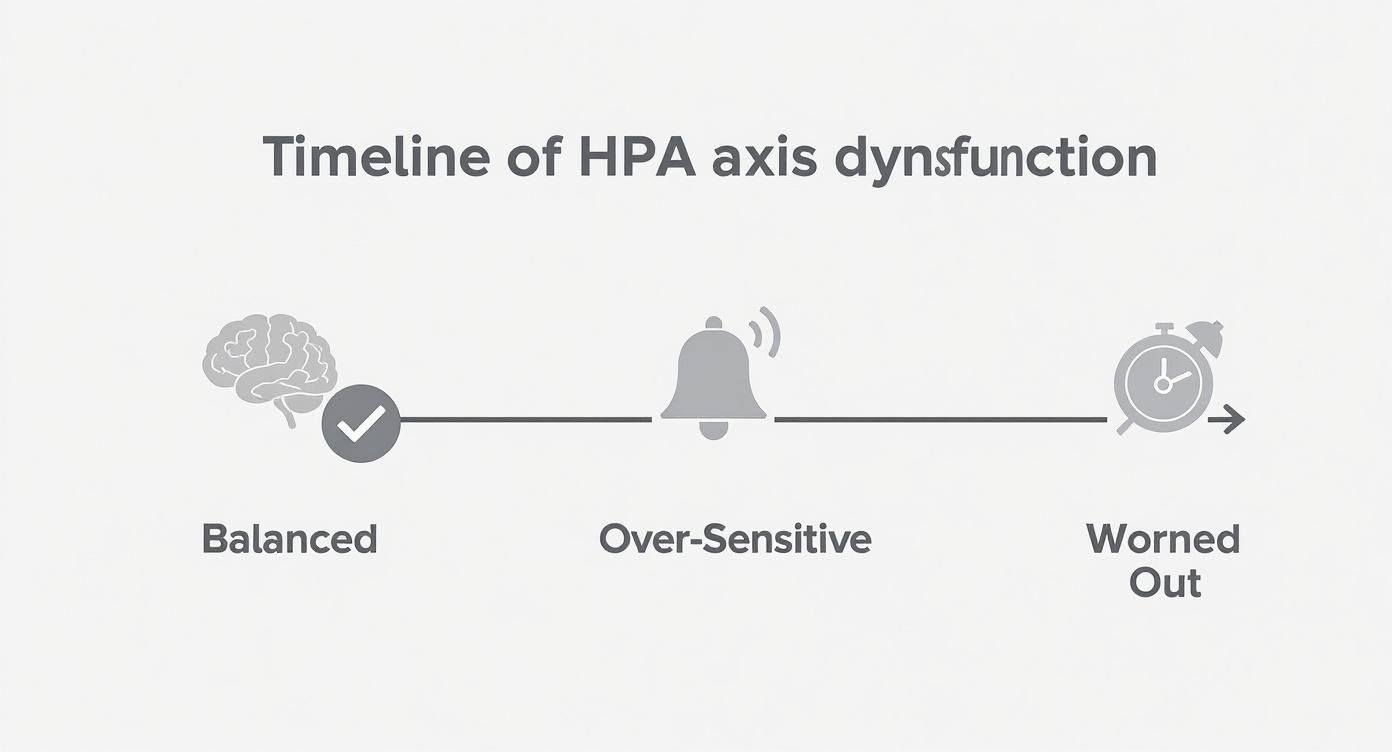When you're dealing with HPA axis dysfunction, the symptoms can feel like a confusing jumble of issues. You might be struggling with relentless fatigue, weird sleep patterns, persistent brain fog, and unpredictable mood swings. These aren't random; they're classic signs that your body’s main stress management system is out of whack.
Essentially, the constant communication between your brain and your adrenal glands has become scrambled due to chronic stress.
Your Body's Internal Stress Management System

Think of your body's stress response as a highly-trained, internal emergency team. This team is called the HPA axis, and it's the command center for handling everything from a sudden fright to the slow burn of a tough work deadline. The name itself comes from its three key players, which work together in a very specific sequence.
The chain of command starts in the brain with the hypothalamus. You can picture it as the system's watchtower, constantly scanning for threats. When it spots one, it sends an alert to the pituitary gland, often called the "master gland."
From there, the pituitary gland relays the message down to the adrenal glands, which sit right on top of your kidneys. They are the frontline responders.
The Cortisol Rhythm
Once the adrenal glands get their marching orders, they release hormones—most notably, cortisol. In a healthy, well-functioning system, cortisol follows a predictable daily rhythm. It's supposed to peak in the morning to get you up and moving, giving you that initial burst of energy.
Throughout the day, it should gradually taper off, hitting its lowest point at night. This dip is crucial for allowing you to wind down and get restful sleep.
This whole setup is perfectly designed for short-term, acute stressors. Once the danger passes, the HPA axis hits the brakes, cortisol levels drop, and your body returns to a state of calm. This communication network is a cornerstone of your overall well-being. A breakdown here can lead to a dysregulated nervous system, affecting everything from your energy levels to your mood.
A healthy HPA axis isn't about avoiding stress entirely. It’s about having a resilient system that can mount an effective response to a stressor and then efficiently return to balance afterward.
When Communication Breaks Down
The problem is, modern life doesn't always throw short-term stressors at us. Instead, we're often bombarded with chronic, low-grade pressures that keep the emergency alarm blaring 24/7. Think about financial worries, relentless work demands, or ongoing emotional struggles—these things don't have a clear "off" switch.
When the HPA axis is fired up over and over again without enough time to recover, its delicate communication system starts to fray. This constant activation is the very foundation of HPA axis dysfunction, and it's what sets the stage for all those disruptive symptoms to follow.
When Your Stress Alarm Stops Working Correctly
When chronic stress isn’t just a bad week but becomes your new normal, the HPA axis—your body’s built-in emergency response system—starts to go haywire. It's a common misconception that the adrenal glands just get "fatigued" and give up. The real problem is much more about a fundamental communication breakdown.
The signals flying between your brain and your adrenal glands get scrambled, leading to a state we call dysregulation.
Imagine it's like a sensitive fire alarm that’s been set off one too many times.
At first, the alarm becomes hyper-reactive. The smallest puff of smoke—a mildly annoying work email, getting stuck in traffic—sets off a full-blown, five-alarm emergency response. This is when you might feel constantly on edge, anxious, or “wired but tired.” Your body is flooding itself with cortisol over things that shouldn’t even register as a threat.
From Overly Sensitive to Worn Out
But no system can stay on high alert forever. Eventually, that constant signaling starts to wear down the entire communication network.
The alarm becomes less and less responsive. Sometimes, it fails to sound even when there’s a real fire. This is the stage where you start feeling that deep, bone-crushing exhaustion and burnout that so many people connect with HPA axis dysfunction symptoms.
Your adrenal glands aren't broken; they're just getting confusing, inconsistent messages from a brain that has rewired itself for a state of perpetual crisis. This isn't just about feeling a little tired; it's a systemic issue with profound consequences for your entire body.
The core problem in HPA axis dysfunction is not gland failure, but signal failure. The communication pathway has been disrupted, leading to an inappropriate and imbalanced stress hormone output.
This ongoing dysregulation has real, measurable effects that go far beyond your energy levels. Chronic stress and the cortisol imbalances that follow can impact your brain health. In fact, studies have linked prolonged HPA axis activation to noticeable changes in brain structure and function.
Conditions like depression and even Alzheimer's disease show connections to this kind of long-term, stress-induced damage. You can read more about the neurological impacts of chronic stress and how they may affect long-term health.
The symptoms you feel are a direct reflection of this internal miscommunication. Whether your system is pumping out too much cortisol, not enough, or releasing it at all the wrong times of day, the end result is a body struggling to find its balance. The entire network, from your brain to your glands, needs a hard reset.
The Three Stages of HPA Axis Imbalance
HPA axis dysfunction doesn’t just happen overnight. It’s a slow burn, developing over time as your body’s stress response system gets pushed to its limits and eventually starts to break down. Think of it as a progression through three distinct stages, each with its own signature hormonal patterns and symptoms.
Knowing where you might fall on this spectrum is the first step toward figuring out what’s going on and how to start feeling better.

As you can see, the journey starts with an alarm system that’s a little too sensitive and can end with one that barely whispers, showing a clear, predictable path of dysregulation.
Stage 1: The Alarm Stage
In this first stage, your HPA axis is on high alert—all the time. Your brain senses constant stress, so it keeps sending the signal to produce more cortisol. Your adrenal glands are still up for the challenge, dutifully pumping out high levels of the hormone to help you power through.
This is the classic “wired but tired” phase. You might feel a persistent sense of urgency, anxiety, or irritability, yet you’re somehow still managing to get everything done. Sleep often suffers because elevated cortisol levels at night make it almost impossible to fully wind down.
Stage 2: The Resistance Stage
After spending too long on high alert, the lines of communication start to get fuzzy. Your brain is still yelling for more cortisol, but your adrenal glands are getting tired and beginning to struggle with the non-stop demand. The pituitary gland might also have a tough time producing enough ACTH to get the adrenals to respond.
At this point, cortisol levels become erratic. You’ll likely experience jarring peaks and deep valleys throughout the day, leading to unpredictable energy crashes, wild mood swings, and powerful cravings for sugar or salt. It's common to feel completely exhausted and overstimulated at the same time as your body fights a losing battle to find its balance.
This stage is a critical turning point where the symptoms of HPA axis dysfunction become much more obvious and disruptive. Your body isn't just adapting anymore; it's actively resisting the chronic stress load.
Stage 3: The Burnout Stage
In the final stage, the entire system essentially throws in the towel and becomes downregulated. Your brain scales back its signals to protect the body from the long-term damage of chronic cortisol exposure. As a result, both ACTH and cortisol levels drop off a cliff.
This leads to a profound, bone-deep exhaustion that no amount of sleep can fix. You might feel physically and emotionally depleted, with zero motivation or resilience left in the tank. Other common symptoms include widespread inflammation, a severely weakened immune system, and debilitating brain fog.
Stages of HPA Axis Dysfunction At a Glance
To make it easier to see the progression, this table breaks down the key differences between each of the three stages.
| Stage | Hormonal Profile | Common Feelings | Key Physical Symptoms |
|---|---|---|---|
| Alarm | High Cortisol | Anxious, irritable, "wired but tired" | Insomnia, digestive issues, high blood pressure |
| Resistance | Fluctuating Cortisol | Moody, unpredictable energy, cravings | Afternoon crashes, weight gain, frequent illness |
| Burnout | Low Cortisol | Exhausted, apathetic, overwhelmed | Chronic fatigue, brain fog, body aches |
Recognizing these patterns is the first real step toward understanding what your body is trying to tell you. From there, you can begin the journey of healing and restoring balance to this essential stress management system.
Key HPA Axis Dysfunction Symptoms to Watch For

Spotting HPA axis dysfunction starts with connecting the dots between symptoms that might seem totally unrelated at first. Because this powerful axis has its hands in everything from your immune system to your sleep schedule, a communication breakdown can cause a ripple effect of problems across your entire body.
Think of these symptoms as flares your body is sending up, signaling that its core stress management system is overloaded and can't keep up. When you group these signs together, a clearer picture emerges of how a stressed-out HPA axis might be showing up in your day-to-day life.
Energy and Sleep Disturbances
One of the first and most obvious signs that your HPA axis is struggling is a major disruption in your energy and sleep. This isn't just about feeling a little tired; it's a profound exhaustion that sticks with you.
When your cortisol rhythm gets scrambled, your natural sleep-wake cycle is one of the first casualties. This is where that classic "wired but tired" feeling comes from—your body is physically spent, but your mind is racing, making it impossible to drift off.
This internal mismatch leads to a cascade of other issues:
- Persistent Fatigue: This is a deep, bone-deep exhaustion that a good night's sleep just doesn't touch. It feels like you’re starting every single day with an empty battery.
- Waking Up at Night: Many people with a dysregulated HPA axis find themselves wide awake between 2 and 4 AM, often with a pounding heart. This happens because cortisol is spiking when it should be at its lowest point.
- Difficulty Waking Up: Even if you get a full eight hours, you might feel like you've been hit by a truck in the morning. That groggy, sluggish feeling happens because your natural morning cortisol surge is blunted, leaving you reaching for coffee just to feel functional.
Mood and Cognitive Challenges
Your brain is incredibly sensitive to the hormonal tides of the HPA axis, which is why mood swings and brain fog are hallmark HPA axis dysfunction symptoms. When cortisol is chronically high, it messes with your neurotransmitters; when it's too low, it leaves you feeling mentally depleted.
This internal chaos often shows up as that frustrating feeling of just not being yourself anymore. You might notice your mental sharpness and emotional resilience have taken a nosedive.
A dysregulated HPA axis doesn't just make you tired; it can fundamentally alter your perception and emotional stability. The brain fog and mood swings you're experiencing are direct physiological responses to hormonal imbalance.
Here are some of the most common mental and emotional red flags:
- Brain Fog: You might struggle to concentrate, forget things easily, or feel a general mental cloudiness that turns even simple tasks into a monumental effort.
- Anxiety and Irritability: Feeling constantly on edge, overwhelmed by minor stressors, or having a hair-trigger temper for no apparent reason are all common signs.
- Low Mood or Apathy: This can show up as a persistent sense of feeling down, emotionally flat, or losing interest in hobbies and activities that you used to love.
Physical Health Symptoms
Beyond the mental and emotional toll, a haywire HPA axis can trigger a whole host of physical symptoms. Imbalanced cortisol levels can weaken your immune defenses, throw your digestion out of whack, and fuel chronic inflammation.
This isn't just an issue for adults, either. HPA axis dysfunction can affect children, especially those dealing with the physical stress of chronic health conditions. For example, research shows that even common treatments like inhaled corticosteroids for asthma can interfere with this sensitive system. One study identified an HPA axis suppression rate of 2.1% in children using this therapy—a significant finding in pediatric care. You can discover more insights about HPA axis function in children to see how even external factors can play a role.
Other physical signs to keep an eye out for include:
- Weakened Immune System: Are you catching every cold that goes around? Or do illnesses seem to hang on forever? This can be a sign of a suppressed immune system.
- Digestive Distress: Issues like bloating, indigestion, or new food sensitivities can pop up as stress hormones disrupt your gut health.
- Cravings for Salt or Sugar: Your body might be desperately seeking quick energy from sugar or trying to support taxed adrenal glands with salt, leading to intense, specific food cravings.
- Unexplained Aches and Pains: Widespread inflammation can cause muscle stiffness, joint pain, and general body aches that have no obvious cause.
The Hidden Stressors That Disrupt Your Balance
Figuring out you have HPA axis dysfunction is a huge first step. But the next logical question is always, "What's actually causing this breakdown?" While "stress" is the easy answer, the reality is a lot more specific and nuanced.
Your body's stress response system doesn’t know the difference between a looming work deadline and a hidden internal problem. To your HPA axis, a threat is a threat, plain and simple.
It’s almost never one single big event that pushes the system off a cliff. Instead, it’s the slow, steady drip of various stressors—what we call the total stress load—that eventually overwhelms your body’s ability to cope. These hidden triggers stack on top of each other and can usually be grouped into a few key categories.
Physical and Environmental Triggers
Physical stressors are tangible things that directly tax your body’s resources. They demand a physiological response, forcing your HPA axis to work overtime even when you don't feel mentally frazzled.
- Poor Nutrition: Diets packed with processed foods, sugar, and inflammatory oils create a state of constant internal stress.
- Hidden Infections: Chronic, low-grade infections from gut imbalances, lurking viruses, or even stubborn dental issues can keep your immune system—and by extension, your HPA axis—on high alert 24/7.
- Environmental Toxins: Everyday exposure to pesticides, heavy metals, and chemicals in consumer products adds to your body's detoxification burden, acting as a persistent, low-level stressor.
Even necessary medical treatments can act as physical triggers. For instance, one study of asthmatic children found a direct link between the dosage of inhaled corticosteroids and HPA axis suppression. The research showed 9.3% of the children had confirmed suppression, with the odds getting worse with higher doses. You can read the full research about medication-induced HPA axis changes for a deeper dive.
Psychological and Emotional Stressors
This is the category most of us immediately think of as "stress." These are the perceived threats that start in our thoughts, emotions, and relationships. Your brain interprets these situations as dangerous, kicking the HPA axis into gear just as it would for a real physical threat.
Your body doesn’t know the difference between being chased by a predator and worrying about a relationship conflict. The physiological stress response is identical, and chronic emotional turmoil can be one of the most significant drivers of HPA axis dysfunction.
Common examples include unresolved trauma, ongoing relationship conflict, financial worries, or a high-pressure job. These persistent mental loads keep cortisol elevated, preventing your system from ever getting back to a state of rest.
Understanding how to manage this is a game-changer. By identifying these hidden drivers in your own life, you can start addressing the root causes and begin the journey toward restoring balance. You can learn more about how to repair your autonomic nervous system in our related guide.
Common Questions About HPA Axis Dysfunction
When you're first diving into HPA axis dysfunction, it's natural to have a lot of questions. The concepts can feel complex, and it’s easy to get lost in the terminology. Let’s clear up some of the most common points of confusion.
Think of this as your go-to guide for direct, simple answers. Getting these fundamentals straight will help you feel more confident about understanding your body's stress response and the path to healing.
Is HPA Axis Dysfunction the Same as Adrenal Fatigue?
No, but it's easy to see why they're often mixed up. They both describe a similar set of symptoms, but the underlying explanation for why those symptoms are happening is very different.
The term “adrenal fatigue” became popular years ago. It suggests that the adrenal glands themselves are simply worn out or "fatigued" from overwork, to the point where they can't produce enough hormones. This isn't really what's happening on a physiological level.
HPA axis dysfunction is a much more accurate way to describe the problem. It points the finger at a breakdown in the communication chain between your brain (the hypothalamus and pituitary) and your adrenal glands. Your adrenals aren’t necessarily tired; they’re just getting mixed-up signals, which leads to the wrong amount of cortisol being released at the wrong times.
The real issue isn’t the glands themselves, but the entire signaling network that controls them. This is a critical distinction because it shifts the focus of healing from simply trying to "boost" the adrenals to rebalancing the entire stress response system.
How Is HPA Axis Dysfunction Diagnosed?
Diagnosing HPA axis dysfunction goes a bit deeper than a typical check-up. A single blood test for cortisol usually isn't enough, as it only gives you a snapshot of one specific moment in your day. Your cortisol levels are supposed to change dramatically, so one data point doesn’t tell the whole story.
Functional medicine practitioners prefer to map out your cortisol rhythm over a full day. This gives a much clearer picture of how your HPA axis is actually behaving.
Common diagnostic tools for this include:
- Multi-Point Salivary Cortisol Tests: This is a simple, at-home test where you collect saliva samples at key times throughout the day—usually when you wake up, at noon, in the late afternoon, and before bed. This tracks your daily cortisol curve.
- DUTCH Test (Dried Urine Test for Comprehensive Hormones): This is another popular test that measures your cortisol patterns over a 24-hour period. It also provides a wealth of information about other hormone metabolites, giving a more complete picture.
A practitioner will look at these test results alongside your health history and a detailed review of your HPA axis dysfunction symptoms to determine which stage of dysregulation you might be in.
Can I Fully Recover from HPA Axis Dysfunction?
Yes, absolutely. Full recovery is entirely possible, but it takes patience, consistency, and a commitment to reducing your body's total stress load. There isn't a magic pill that can fix this overnight.
Healing is all about making strategic, long-term lifestyle changes that allow your nervous system to recalibrate. This means optimizing your sleep, eating nutrient-dense foods, incorporating gentle movement, and actively practicing stress-reduction techniques.
A huge piece of the puzzle for many people is learning how to activate the "rest and digest" side of their nervous system. For practical ways to do this, check out our guide on parasympathetic nervous system stimulation. Restoring balance is a journey, but it’s one you can definitely complete.

